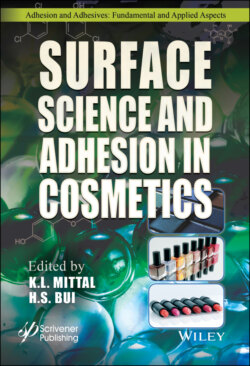Читать книгу Surface Science and Adhesion in Cosmetics - Группа авторов - Страница 2
Table of Contents
Оглавление1 Cover
2 Title Page
3 Copyright
4 Preface
5 Part 1: GENERAL TOPICS 1 Lip Biophysical Properties and Characterization Methods for Long-Wear Lipsticks 1.1 Introduction 1.2 Overview of Lip Anatomy & Lip Surface Properties 1.3 In Vitro Evaluation Methods for Lipsticks 1.4 Relation of In Vitro Analysis with Consumer Sensory Testing 1.5 Summary Acknowledgements References 2 Effect of Cosmetic Oils on Lipstick Structure and Its Deposit 2.1 Introduction 2.2 Types of Natural Waxes, Their Physical Properties and Potential Applications 2.3 Factors Affecting Oil-Wax Structures 2.4 Study On Model Oil-Wax System Containing Polyethylene Wax 2.5 Results and Discussion 2.6 Summary Acknowledgements References 3 UV Curing of Nail Gels by Light Emitting Diode (LED) and Fluorescent (FL) Light Sources 3.1 Introduction 3.2 UV Cure Chemistry 3.3 UV Cure Light Sources: Gallium-Doped Low-Wattage Long Wavelength Fluorescent (FL) Bulbs and Light Emitting Diodes (LEDs) 3.4 UV Cure Oxygen Inhibition Issues 3.5 Special Considerations for the Use of UV Nail Gel Technology Due to Oxygen Inhibition 3.6 How to Formulate a UV-A Cure Nail Gel 3.7 Formulation of UV Nail Gels with 100% Solids UV Cure Oligomers and Monomers 3.8 Human Nail Mechanical and Surface Free Energy Properties 3.9 Adhesion of UV Nail Gel to the Human Nail Plate 3.10 Removal of the UV Nail Gel From the Human Nail Plate 3.11 Alternative Uses of UV Cured Nail Gels as a Solution to Remedy Onychomycosis (Toenail Fungus) 3.12 UV-Cured Nail Gel Safety 3.13 Prospects on UV Nail Gels 3.14 Summary Acknowledgements References 4 Rheological Properties Influence Tackiness, Application and Performance of Nail Polish/Lacquer Formulations 4.1 Introduction 4.2 Typical Ingredients of a Nail Polish Formulation 4.3 Rheological Response of Nail Polishes: Background 4.4 Methods for Characterizing Flow Behavior and Application to Nail Polishes 4.5 Materials: Ingredients of the Twelve Nail Polishes 4.6 Results and Discussion 4.7 Summary and Conclusions Acknowledgements References 5 Use of Advanced Silicone Materials in Long-Lasting Cosmetics 5.1 Introduction 5.2 Adhesion to Skin 5.3 Formulation Strategies for Long-Lasting Cosmetics 5.4 Advanced Silicone Materials for Long-Wear Cosmetics 5.5 Summary and Prospective Film-Formers for Long-Wear Cosmetics Acknowledgements References
6 Part 2: SURFACE SCIENCE ASPECTS 6 Advances in the Chemical Structure of the Hair Surface, Surface Forces and Interactions 6.1 Introduction 6.2 Structure of Hair and the Outermost Surface 6.3 Chemical and Physical Modifications of the Hair Surface 6.4 Local Physico-Chemical Understanding of the Hair Surface 6.5 Macroscopic Understanding of the Chemical Nature of the Hair Surface 6.6 Impact of the Hair Chemical Nature on Sensorial and Consumer Benefits 6.7 Prospects 6.8 Summary Acknowledgements References 7 AFM for Hair Surface Characterisation 7.1 Hair Structure 7.2 Elements of AFM 7.3 The Use of AFM to Characterize the Hair Surface/Cuticle 7.4 Cosmetic Treatment (e.g. Bleaching) as Shown by AFM 7.5 Summary References 8 Atomic Force Microscopy (AFM) as a Surface Characterization Tool for Hair, Skin, and Cosmetic Deposition 8.1 Introduction 8.2 Atomic Force Microscopy Compared to Other Microscopy Techniques 8.3 The Principles of Atomic Force Microscopy 8.4 A Brief History of Hair Surface Investigation via Atomic Force Microscopy 8.5 Lateral Force Microscopy (LFM) of the Hair Surface 8.6 Adhesion at the Nanoscale via AFM 8.7 Elastic Modulus Measurement via AFM 8.8 Hair Studies via AFM 8.9 Skin Studies via AFM 8.10 Summary and Prospects References 9 Secondary Ion Mass Spectrometry as a Surface Analysis Method for Hair, Skin, and Cosmetics 9.1 Introduction 9.2 Secondary Ion Mass Spectrometry (SIMS) 9.3 Studying the Skin via TOF-SIMS 9.4 Studying the Hair Via TOF-SIMS 9.5 Future Prospects References
7 Part 3: WETTING AND ADHESION ASPECTS 10 Surface Tensiometry Approach to Characterize Cosmetic Products in the Beauty Sector 10.1 Introduction 10.2 Peels 10.3 Face Masks 10.4 Serums 10.5 Eye Contour Creams 10.6 Mascara 10.7 Eyeshadows 10.8 Lipsticks 10.9 Foundation 10.10 Anti-Aging Formulations 10.11 Summary Acknowledgement References 11 Spreading of Hairsprays on Hair 11.1 Introduction 11.2 Background on Interaction of Liquid Droplets with Fibers 11.3 Materials and Experimental Methods 11.4 Results and Discussion 11.5 General Observations on the Behavior of Holding Spray on Hair 11.6 Shine Spray on One Bleached Hair Fiber 11.7 Summary Acknowledgements References 12 Quantification of the Color Transfer from Long-Wear Face Foundation Products: The Relevance of Wettability 12.1 Introduction 12.2 Experiments 12.3 Results and Discussion 12.4 Summary and Perspectives Acknowledgments References 13 Interaction of Polyelectrolytes and Surfactants on Hair Surfaces. Deposits and their Characterization 13.1 Introduction 13.2 Hair Structure and its External Surface 13.3 Experimental Approaches for the Evaluation of the Deposition of Polyelectrolyte-Surfactant Systems onto Model Surfaces 13.4 Theoretical Modelling of Polyelectrolyte-Surfactant Mixtures 13.5 Prospects 13.6 Summary Acknowledgements References 14 Adhesion Aspect and Film-Forming Properties of Hydrocarbon Polymers-Based Lipsticks 14.1 Introduction 14.2 Synthesis and Characterization of the Model Oil Compatible Polymers Dispersions 14.3 NADs as Film-Formers for Long-Wear, Non-Transfer Lipstick 14.4 Summary and Prospects Acknowledgements Annex References 15 Factors Enhancing Adhesion of Color Cosmetic Products to Skin: The Role of Pigments and Fillers 15.1 Introduction 15.2 Overview of Pigments: Basic Physico-chemical Considerations in Long-Wear Color Cosmetics 15.3 Factors Affecting Adhesion of Long-Wear Color Cosmetics 15.4 Summary and Prospects Acknowledgments References 16 Factors Affecting Cosmetics Adhesion to Facial Skin 16.1 Introduction 16.2 Factors Affecting Adhesion to Skin: Skin Substrate Properties 16.3 Factors Affecting Adhesion to Skin: Formulation Components 16.4 Factors Affecting Adhesion to Skin: Combination of Film-Formers and Emulsifiers 16.5 Summary and Prospects Acknowledgements References 17 Adhesion Aspect in Semi-Permanent Mascara 17.1 Introduction 17.2 Structure of Eyelash and Eye Lid: An Overview 17.3 Types of Mascaras 17.4 Components in Mascara Formulations 17.5 Long-Wear Mascaras 17.6 Evaluation Methods for Long-Wear Mascara 17.7 Factors Affecting Adhesion of Mascara to an Eyelash 17.8 Removability of Mascara 17.9 Summary and Prospects Acknowledgments References 18 Lipstick Adhesion Measurement 18.1 Introduction 18.2 Definition of Adhesion 18.3 Sensory Metrology: Subjective Methods 18.4 Mechanical Tests: Objective Methods 18.5 Correlation Between Sensory and Instrumental Tests 18.6 Summary Acknowledgments References
8 Index
9 Also of Interest
10 End User License Agreement
